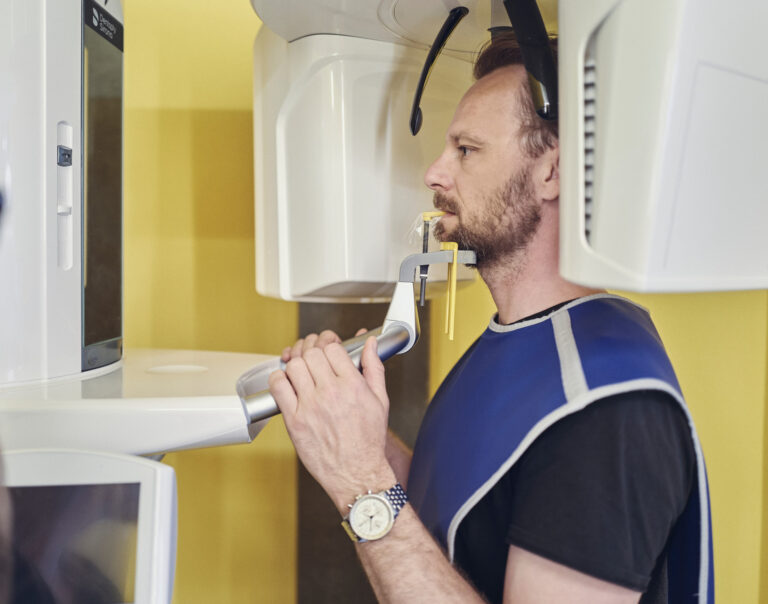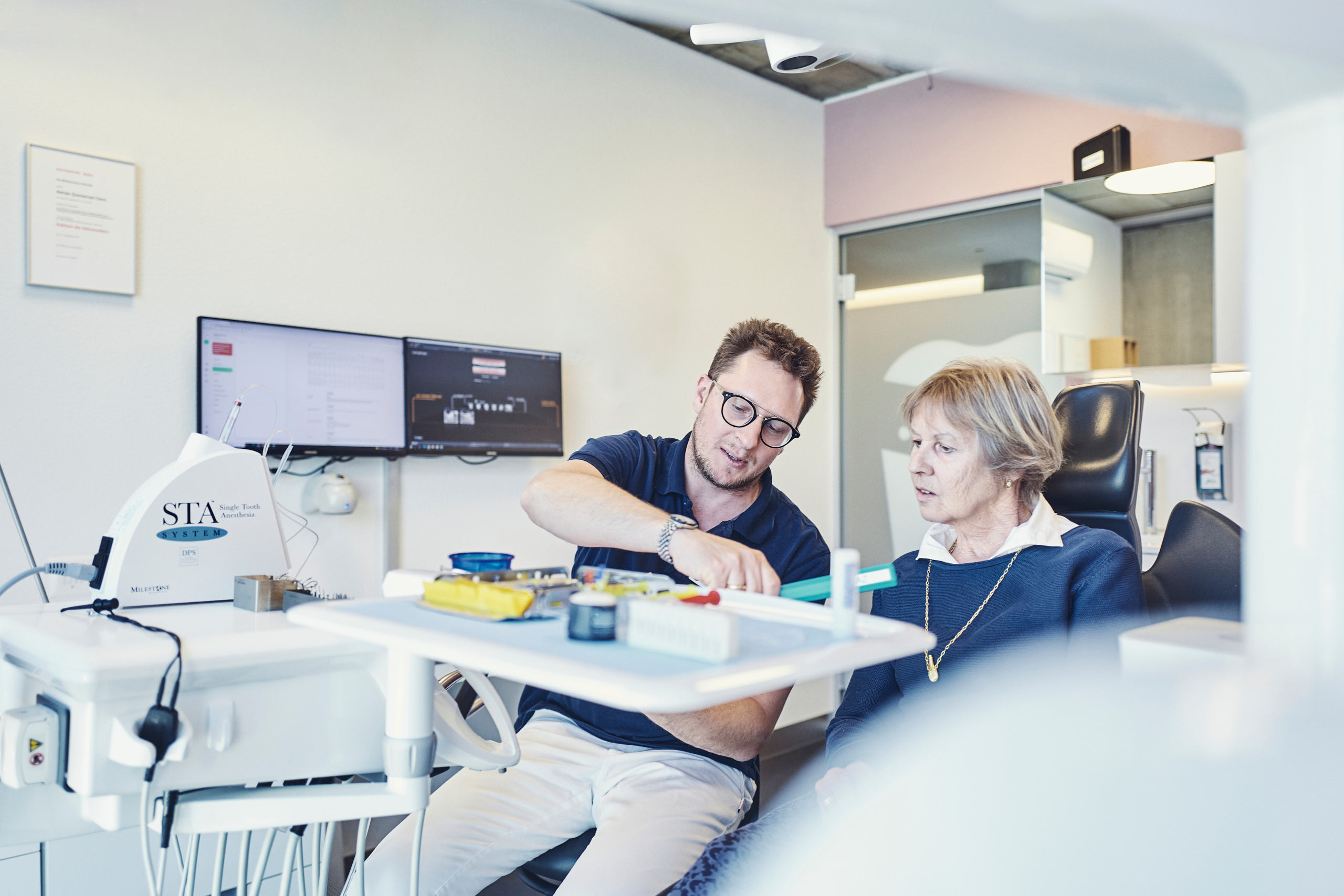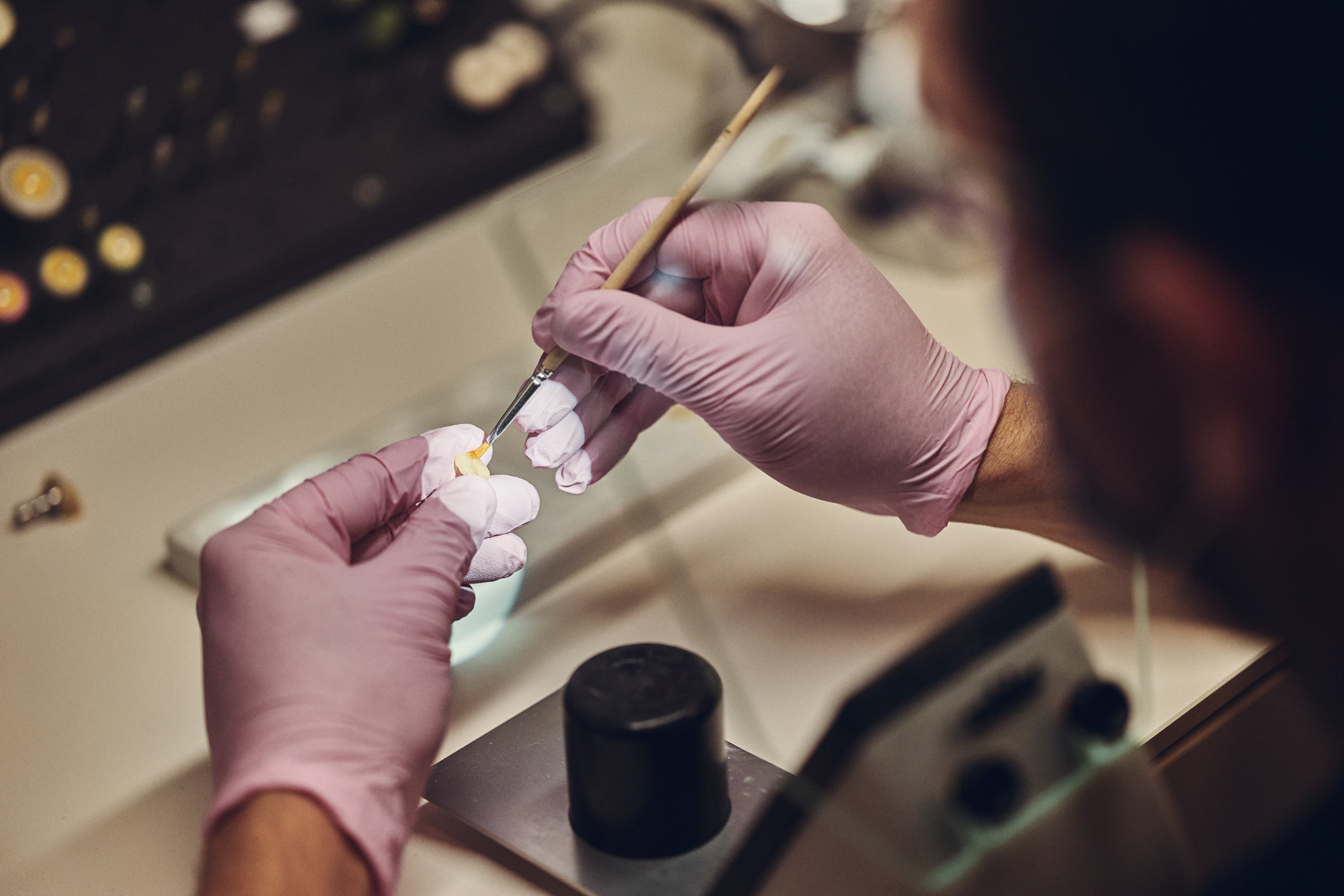Ceramic restorations with the CEREC system
When is CEREC used?
Smaller dental defects are often repaired using minimally invasive composite fillings. However, if the defect is too large, there is a risk that the repaired tooth becomes unstable, causing the composite filling—or, in the worst-case scenario, the tooth itself—to break under heavy chewing pressure. In such cases, a ceramic restoration (crown, inlay, onlay, or overlay) is indicated. The tooth is first prepared by reshaping it. An impression is then taken of the prepared tooth, and a restoration is created based on this model to be fitted later.
The CEREC system is used in this final step and allows for significant time savings.
Why Choose CEREC at Züri Zahni in Glattpark Zurich?
Fast and Precise
With CEREC, you benefit from same-day dental restorations – no need for a temporary crown or overlay. Since the final crown is crafted and glazed right in our in-house lab, the treatment is quick and seamless.
State-of-the-Art Technology
Thanks to CEREC’s cutting-edge technology – including the Primescan scanner, Primemill milling unit, and Speedfire furnace, all supported by the latest CEREC software – we guarantee top precision, efficiency, and reliability for every treatment.
Experience the Creation of Your Restoration
Watch live as your dental restoration is designed and milled in our Primemill unit. Experience the fascinating moment when your crown takes shape and is brought to life – a treatment that impresses!
Interview with Adrian Cano
We Offer Full Range CEREC Treatment

Digital Impressions
Our advanced scanner enables precise digital impressions of your teeth. This step is not only more comfortable than traditional impressions with molding materials but also significantly faster and more efficient. A clean digital impression lays the foundation for a perfectly fitting dental restoration.

Efficient Digital Workflow
Thanks to digital scans and models, physical plaster or resin models are no longer needed. This fully digital process minimizes potential transfer errors, providing faster, more precise, and efficient design that significantly reduces treatment time.

Extensive Material Selection
We select the restoration material based on each case and offer high-quality options from premium manufacturers like Ivoclar, GC, Kuraray, and Dentsply, among others. This ensures top-notch quality, durability, and aesthetics.
CEREC vs. Conventional/Indirect Method by a Dental Technician
Conventional, indirect method
CEREC
Impression
With impression material
With a 3D digital camera
Laboratory
1. Pouring the model in plaster
2. Sculpting the tooth in wax
3. Pressing the ceramic
4. Polishing/painting
1. Digital design
2. Milling from a ceramic block
3. Polishing, painting, and firing
Fabrication time
7 to 10 days
30 minutes to 2 hours
Placement of the restoration
After fabrication
On the same day or the next day
Cost of fabrication
+++
+

Personalized Consultation and Treatment by Our Experts
My name is Adrian Cano, and I am responsible for CEREC treatments at Züri Zahni. With cutting-edge technology and extensive expertise, we focus on delivering customized, long-lasting dental restorations that we create right here in our in-house lab. Together with our experienced team, we guarantee a fast, personalized restoration that will ideally serve you for many years.
Schedule your appointment at Züri Zahni today and experience the future of dental restorations – efficient, aesthetic, and tailored to your individual needs.
WHAT OUR CUSTOMERS SAY ABOUT US
AS SEEN ON:

Questions & Answers
CEREC, short for “Chairside Economical Restoration of Esthetic Ceramics,” is an innovative technology that allows us to create precise, high-quality ceramic restorations directly in our dental practice. The CEREC system combines advanced devices: a 3D camera for digital scanning, a state-of-the-art CAD-CAM milling machine for milling the ceramic, and a specialized oven for hardening and finishing the restoration. This technology enables us to design, produce, and place a custom ceramic restoration in a single visit—delivering fast results and maximum convenience.
The CEREC technology originated in Switzerland and was developed in 1980 by pioneers Werner H. Mörmann and Marco Brandestini at the University of Zurich. The first version, known as CEREC 1, was introduced to the market by Siemens in 1987. Since then, CEREC has undergone continuous development and has been a proven method for over 40 years, offering excellent results and high patient satisfaction.
With the CEREC system, we can create various types of ceramic restorations, including:
Crowns:
To replace the entire tooth crown. There are three main types: full crowns (cover the entire tooth), partial crowns (cover only part of the tooth), or endodontic crowns (positioned within the access cavity created during root canal treatment).
Inlays and Onlays:
For reconstructing parts of the tooth crown. Inlays fill cavities, while onlays also cover the tooth cusps.
Overlays:
Similar to onlays but covering a larger area of the tooth.
Veneers:
Thin shells for the front teeth. CEREC veneers are suitable for less aesthetic-demanding cases. For highly aesthetic cases, the craftsmanship of a dental technician is required.
Bridges:
To replace missing teeth by connecting two or more teeth. Bridges can include up to 4 units in the front and premolar areas or up to 3 units in the molar region.
CEREC treatment is generally painless as we use local anesthesia similar to that used for conventional fillings. To enhance patient comfort, we use “The Wand,” a modern anesthesia device that administers the anesthetic gently and precisely. In some cases, minor gum polishing may be necessary, which could cause slight irritation. These soft tissue wounds usually heal within a few days. After treatment, the tooth might be sensitive for a few days or weeks or feel slightly different due to the altered bite.
Before the treatment, make sure to brush and floss your teeth thoroughly. Inform your dentist about any medications you’re taking and any health conditions you may have.
1. Preliminary Examination
At the beginning of the CEREC treatment, we conduct a thorough examination. This includes measuring the periodontal pockets, taking an X-ray, performing a vitality test, assessing tooth mobility, and performing a percussion test to determine the tooth’s sensitivity to pain. These steps ensure the tooth is suitable for a CEREC restoration.
2. Anesthesia and Isolation
For pain-free treatment, we use “The Wand” system, a particularly gentle method of local anesthesia. The tooth is then isolated with a rubber dam or Iso Vac to create a dry and clean working field.
3. Removal of Old Restorations
Old fillings or restorations are removed. If the margins are located too deep subgingivally, a box elevation is performed to position the margins of the new CEREC restoration further away from the gingiva. This ensures clean isolation and prevents moisture or blood from contaminating the restoration margins.
4. Tooth Preparation
The tooth is prepared for the CEREC restoration by shaping it accordingly. This may involve shortening cusps or reducing the tooth’s occlusion to optimize force distribution and minimize the risk of fractures in the remaining tooth structure.
5. Digital Scan and Bite Registration
Using the CEREC Primescan, we create a precise 3D impression of the prepared tooth, the entire upper and lower arches, and a bite registration. After the scan, we select the shade to ensure the restoration matches the surrounding teeth perfectly.
6. Designing the CEREC Restoration
The individual restoration is digitally designed and customized using the CEREC software. We ensure that there are no interferences in the occlusion and that the contact points fit snugly to guarantee a perfect fit.
7. Fabrication of the CEREC Restoration
The digitally designed restoration is milled from a ceramic block using the CEREC Primemill. This process takes only a few minutes.
8. Trial Fitting, Refinement, and Placement
The CEREC restoration is checked before placement and adjusted if necessary. It is then fired in the SpeedFire oven, glazed if needed, and conditioned. The final restoration is placed using a special composite cement. Excess cement is removed, and the restoration is carefully polished.
9. Completion and Follow-Up
After the CEREC treatment, we check the bite and take a control X-ray. A follow-up appointment after 1–2 weeks may be recommended to ensure the long-term success of the treatment.
After your CEREC treatment, the anesthesia may remain effective for some time, meaning there’s a risk of accidentally biting your cheeks or tongue. It’s recommended to wait until the numbness has fully worn off before eating or drinking. Additionally, fluoride is applied to remineralize any demineralized areas. Avoid eating or drinking for at least one hour after the procedure.
Yes! To ensure the longevity of your CEREC restoration, we recommend the following:
- Electric or sonic toothbrush: These are more effective at removing plaque.
- Fluoride toothpaste and fluoride gel: Strengthen the teeth and prevent decay.
- Tongue cleaning: Reduces bacterial buildup in the mouth.
- Flossing and/or interdental brushes: Keep the spaces between your teeth clean.
- Regular check-ups: Schedule dental hygiene (DH) visits at least once or ideally twice a year to maintain oral health.
On average, a CEREC crown lasts between 5 to 10 years. With good care and maintenance, they can last even longer.
The cost of a CEREC crown is approximately CHF 1,500, whereas a conventional crown may cost around CHF 2,500. These figures are estimates and can vary based on individual circumstances. Additional treatments such as root canals, gingivoplasty/gingivectomy, or gum conditioning may increase the cost.
CEREC restorations are suitable for most patients requiring tooth reconstruction. Your dentist will carry out a thorough examination to determine if this method is appropriate for your specific dental needs.
A CEREC restoration might not be the best choice in the following situations:
- Small defects: For minor tooth defects, a conventional filling is often sufficient.
- Non-restorable tooth: If the tooth is severely damaged or unsalvageable, an extraction may be necessary.
- Periodontal issues: If gum health is compromised, the focus should first be on improving periodontal health before placing a restoration.
- Extremely deep margins: When the margins of the restoration are located deep below the gumline and are difficult to access, a box elevation, crown lengthening, surgical repositioning, or orthodontic extrusion must first be performed.
- High aesthetic demands for veneers: While CEREC can fabricate veneers, cases with very high aesthetic demands may require a dental technician’s expertise.
- Poor oral hygiene: For patients with poor oral hygiene and a high risk of cavities, achieving long-term success may be more challenging.
In our practice, we use the latest models from the CEREC range: CEREC Primescan, Primemill, and SpeedFire. Our materials come exclusively from top-tier, well-researched, and clinically proven companies like Ivoclar, GC, Dentsply Sirona, Kuraray Noritake, and others.










